Contents: Species, Interesting Facts, Identification, Song, Distribution, Preferred Nesting Habitat, Diet, Nesting Behavior, Nestboxes, Nestbox Location, Recommended Distance Between Nestboxes, Monitoring, Nesting Timetable, Longevity, More Info. Also see photos of nests, eggs, young and adults
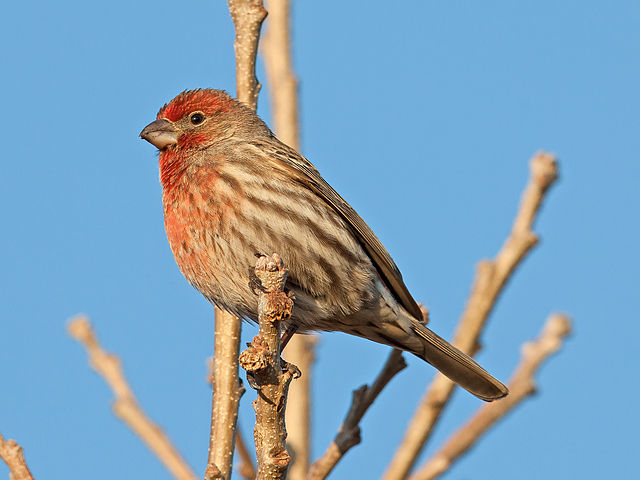
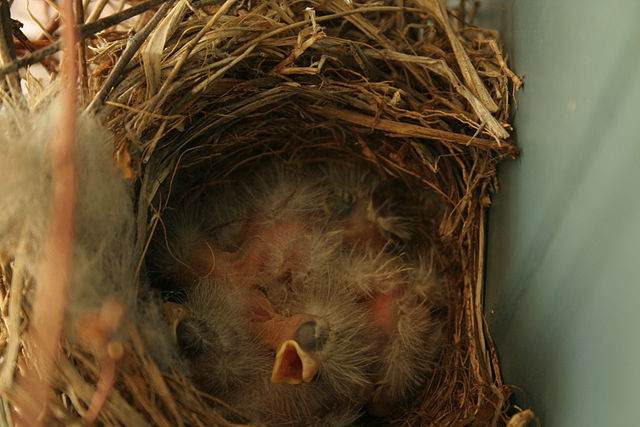
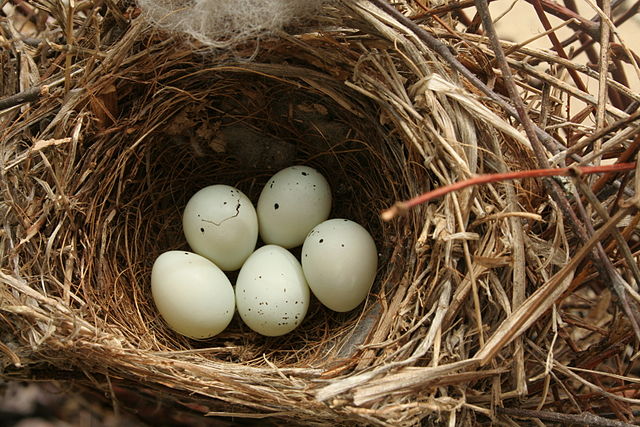
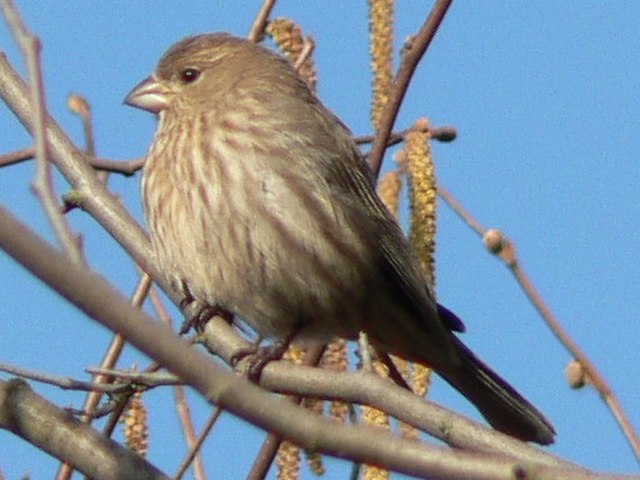 Species: The House Finch (HOFI), scientific name, is divided into four species, with a total of 18 subspecies.
Species: The House Finch (HOFI), scientific name, is divided into four species, with a total of 18 subspecies.
Other Names: Used to be called a Hollywood Finch or Linnet.
- House finches are not native to North America. Their range has expanded dramatically. A small number of House Finches trapped in California were set loose on Long Island (NY) in 1940, after failed attempts to sell them as caged “Hollywood finches.” They have since spread throughout the continental U.S. They were introduced to Hawaii in 1870, and were found on all the major Hawaii islands by 1901 (All About Birds, Cornell)
- In Mexico, large numbers are legally trapped and sold as pets. (BNA)
- They are minor agricultural pests in California due to predation in orchards. In Hawaii, they are are a problem in grain fields (e.g., sorghum.) (BNA)
- They probably don’t migrate much (maybe changing altitude) in many areas, although they may “erupt” beyond normal breeding ranges. In the East, they may winter in the south. (BNA)
- Since 1994, many House Finches have been seen at bird feeders with an eye disease called mycoplasmal conjunctivitis. It can kill them or make them easy prey. It is not harmful to humans. (All About Birds)
- Unlike most seed eating birds that feed their nestlings insects, House Finches only feed their young vegetable matter. As a result, a cowbird nestling parasitizing a HOFI nest usually dies.
- House Finch nestlings often create a “poop wreath” of fecal sacs around the edge of the nest, as they position their butts to defecate there after feeding.
Identification: An adaptable, common bird feeder bird. Small, short, drab gray brown with heavy streaking below, a large beak and sort of long, flat heads, with short wings and a shallow notch in the tail. Male plumage varies quite a bit, from pale yellow (especially on captive birds) to rosy/bright red on their crown, back, eyebrow stripe, cheek, shoulder patch, rump and upper breast. Some females have a little reddish coloring, but are mostly plain grayish brown with thick, blurry streaks and an indistinctly marked face. Likely to be confused with Purple and Cassin’s Finches. Male HOFI do not have as much coloring as Purple Finches (which have more red on nape and back), and have heavier streaking on their breast and lack the distinctive back streaks of a Cassin’s Finch. Females differ from Purple and Cassin’s Finches by having a less contrasting pattern overall, with a relatively plain gray-brown face (vs. sharp streaks against white.) Cassin’s finches have a longer, more pointed bill and less streaking on the sides (and it is finer.) Juvenile HOFI look like adults but the streaking on their breast is finer. May also be confused with House Sparrows. They do not attack nests of cavity-nesters like House Sparrows do. Their eggs and nest shape differ, and adults have a striped breast which differs from a House Sparrow. Male HOFIs do not have a gray cap or black bib.
Distribution: All over the U.S. except parts of the midwest, some southern parts of Canada. See BBS Map.
Preferred Nesting Habitat: Disturbed areas near humans, such as backyards, parks, urban centers, farms and forest edges. Not found in open grasslands or desert flats far from things they can nest and perch on, or in dense coniferous forests.
They are not “obligate” cavity nesters like bluebirds, and rarely use a nestbox. There have been a few documented cases (see Nestboxes below).
Diet: 97% of their diet is buds (e.g., lilac, apple), seeds and fruits (Beal 1907.) Babies are only fed vegetable matter (weed seeds, small sunflower seeds, thistle, poison oak, dandelion seeds) Food includes weed seeds (thistle, mustard, knotweed), commercial fruits in late summer (cherries, apricots, pears, peaches, plums, strawberries, blackberries and figs) and mulberries. They may also eat suet.
Nesting Behavior: Rarely reported nesting in a birdhouse.. They usually make a cup-shaped nest in pine, spruce (in the interior of the tree, near the trunk or in the fork of a limb) and palm trees, cactus, ledges, vents, ivy, street lamps, hanging planters, ledges, abandoned nests of other birds (e.g., orioles), wreaths on doors, tin cans, old hats, stove pipes.
Nest ID: The nest is typically constructed of grass, twigs and trash. Poop wreath “grows” around the edges of the nest as the nestlings age.
Nestboxes: They may use a slot box with a larger opening (e.g., 2-3″). One used a box mounted in a sheltered corner of a front porch. I have had them nest in a metal Purple Martin house mounted on a tall pole.
There are rare reports of use of nestboxes (e.g., in a metal Purple Martin house.) Lee Pauser of California has had them use kestrel and owl boxes on his trails, and sometimes in bluebird boxes. Ethan Heinold also found a HOFI nest in a box mounted under the eave of his house, and developed a box called an “eavebox” which has a triangular opening that faces bottom and down. See photo here: https://nestwatch.org/wp-content/uploads/2022/07/HOFI_nestbox_EthanHeinold-1024×768.jpg
Nestbox Location: ? They tend to hang around humans, since they are a source of food, water and cover. In trees, nests are often 5-7 above the ground, but may be lower or much higher. May prefer sunny locations.
Recommended distance between nestboxes: ?
Monitoring: Disturbing the nest around day 12 (after hatching) is likely to result in premature fledging. Adults are pretty oblivious to humans, but may dodge into a nearby bush or tree.
Nesting Timetable (typical): Pairs form in late winter/early spring. Some stay together year round.
- Excavation or nest site selection: Females do most of the prospecting, but males keep them company and check out the site too. The female builds the nest.
- Nest construction: Usually begins in mid-late March, built quickly (2 days to 2 weeks)by the female (although the male may hang around). Nest of twigs, grasses and debris. May be primarily of slender, dry stems with small leaves attached, lined with soft, wooly branch tips. May contain grass stems, plant fibers, leaves, rootlets, hairs, string and wool, lichens.
- Egg laying: 2-6 eggs, typically 4-5, from late March to late July, depending on location. One egg laid each day, although disturbance (e.g., by a cat or House Sparrow) may result in a day being skipped. In CT, they are ahead of other cavity nesters in starting a nest. Eggs typically oval, smooth shell, slight gloss, pale bluish white/green with sparing, delicate black (or dark brown or olive) spots/dots, speckles or streaks on the large end of the egg, forming a fine, loose ring. Occasionally eggs are unmarked. Length may vary (from 17.5 to 22.4 mm.) Eggs are typically laid in the early morning, with the first one a day or several days after nest construction ends. Eggs can withstand pretty cool temperatures.
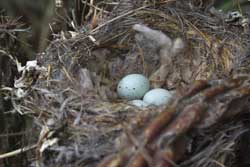
Incubation: 13-14 days (12-17 possible.) Begins when the last egg is laid, or the next to last. During egg laying the female may incubate early and late in the day. Only the female incubates. The male feeds the female during incubation and brooding via regurgitation. (Bent)
- Hatching: Female removes egg shells. Babies are naked except for fine, white down along feather tracts, with pinkish/yellowish looking skin, a yellow gape and red mouth lining. Hatching may occur over 1-3 days.
- Development: The female broods steadily for the first few days after hatching. Mite infestation of the nest may be high.
- Day 2: can crawl feebly and place heads on edge of nest
- Day 3: juvenile plumage appears. Eyes start to open day 3-4.
- Day 5: can lower heads and raise butts to lip of nest to deposit feces, eventually creating a “wreath” of fecal sacs around nest edges. Around day 4-5, the adults stop eating the fecal sacs so they build up. Ensheathed feathers begin to appear on back and breast. Nestlings grip nesting material with feet to resist being taken from nest.
- Day 6: back and breast feathers begin to emerge from sheaths.
- Day 8: not yet timid of humans
- Day 8-9: more vocal (begging loudly when parents approach)
- Day 10: timid of humans, sometimes perch on edge of nest and fan wings. Hold their eyes open and look alert.
- Day 12: appear fully feathered.
- Fledging: Around Day 16. They leave without parental provocation. Wing and tail feathers do not reach full length until after leaving the nest. Young beg so intensely that it looks almost like fighting. Not known how long young depend on parents.
- Dispersal:
- Number of broods: Usually 2, possibly 3. The male feeds the babies from the previous brood while the female builds a new nest and lays the next clutch. Sometimes females start the second clutch a few days before the young fledge from the first nest (Evenden 1957.) If a nest is lost, they quickly rebuild – usually starting within a day. Marked tendency to return to the same nesting spot for subsequent broods and in subsequent years if they survive.
- Longevity: 11 years, 7 mos (All About Birds)
NOTE: HOUSE FINCH DESTROYS CHICKADEE NEST: Chickadees immediately built a nest in a box. After a couple weeks, A female housefinch threw the contents of the nest (dog & cat hair) out of the box. The added the wren blocker & the chickadees rebuilt the next about 2 weeks later. The house finches were no longer attracted to the nestbox. (Karen Crisfulla of South Jersey.) NOTE FROM Bet: This sounds like House WREN behavior, not sure if the reporter was mistaken?
References and More Information:
- Nest and Egg ID (with links to species biology and photos of nests, eggs and young) for other small cavity nesters
- Hill, Geoffrey E. 1993. House Finch (Carpodacus mexicanus), The Birds of North America Online (A. Poole, Ed.). Ithaca: Cornell Lab of Ornithology; Retrieved from the Birds of North America Online: doi:10.2173/bna.46
- Life Histories of Familiar North American Birds, Robert S. Woods, published 1968
- Nestwatch blog: https://nestwatch.org/wp-content/uploads/2022/07/HOFI_nestbox_EthanHeinold-1024×768.jpg
To the average city dweller, its domestic tastes, cheerful song, amiable manner, and the bright coloring of the male make it a pleasing adjunct to the dooryard or window sill; but a grower of the softer varieties of fruit who watches flocks of these birds descend like locusts upon his ripening crop finds difficulty in appreciating their esthetic values.
– Robert S. Woods, from Life Histories of Familiar North American Birds
